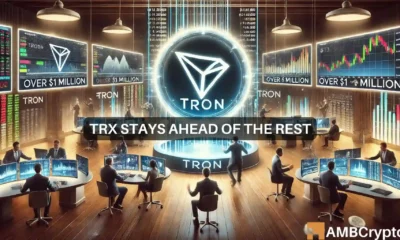Ethereum
Whales dump Ethereum – should you be concerned?
Amidst dwindling whale interest, Ethereum’s network witnesses a surge in non-zero addresses, showcasing retail investor enthusiasm.
- Ethereum whale liquidation amidst market volatility raised concerns about dwindling engagement.
- Despite whale disinterest, Ethereum saw a surge in non-zero addresses, indicating retail investors’ continued interest.
In the wake of a significant Bitcoin correction that reverberated through the cryptocurrency market over the past few days, causing price fluctuations across various coins, Ethereum [ETH] also experienced notable impacts.
Is your portfolio green? Check out the Ethereum Profit Calculator
Due to these factors, whales started to sell large portions of their ETH.
According to Lookonchain, a sizeable whale liquidated a 10,600 ETH valued at $17.2 million, at a price point of $1,622. This transaction incurred a loss of $2.9 million for the whale.
A whale dumped 10,600 $ETH($17.2M) at a price of $1,622 7 hrs ago, with a loss of $2.9M.
The whale traded a total of 18 tokens, and only 4 tokens were profitable, with a win rate of 22%.
He currently has a profit of $10.8M on $ETH, but lost $3.6M on $PDT and $1.3M on $MPL. pic.twitter.com/GzPl8WyHx6
— Lookonchain (@lookonchain) August 23, 2023
A more comprehensive examination of the transaction data painted a broader picture. The said whale ventured into 18 different token trades, with only four of them turning out to be profitable. This translated to a relatively modest success rate of 22%.
Although the whale managed to accumulate a profit of $10.8 million from its Ethereum holdings, the situation is not entirely favorable. It also incurred a $3.6 million loss on PDT trades and an additional 1.3 million loss on $MPL trades.
As whale interest in Ethereum seems to wane, retail engagement tells a different tale. Illustrated by data from Glassnode, the number of non-zero addresses skyrocketed to an all-time high of 104,794,621.
This suggested sustained interest among individual users despite the ongoing market volatility.
Ethereum’s market activity took center stage as the Exchange Inflow Volume surged to a 1-month peak of 9,630.147 ETH. This surge in inflows into exchanges could potentially reflect evolving market sentiment and highlight potential selling pressures.
Nevertheless, despite the increase in exchange inflows, Ethereum’s network activity exhibited a divergent trajectory. Low gas usage indicated a reduction in general network activity, particularly in terms of smart contract interactions.
In contrast, the NFT sector seemed to maintain relatively stable activity levels.
Ethereum’s current landscape
Due to the behavior of whales and other factors, Ethereum’s price shifted from $1820 to $1627 over the last week, indicating a noticeable decline. Network growth also experienced a slowdown, suggesting a possible decrease in new user onboarding.
Realistic or not, here’s ETH’s market cap in BTC’s terms
Furthermore, Ethereum’s transaction velocity exhibited a decline, hinting at less frequent trading activities.
The MVRV ratio, a metric used to gauge whether holders are experiencing profits or losses at a given time, offered a mixed perspective for Ethereum. The negative MVRV ratio implied that a significant portion of Ethereum holders were not realizing profits at press time.
